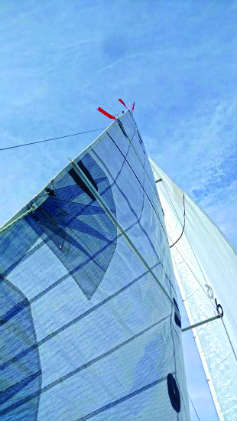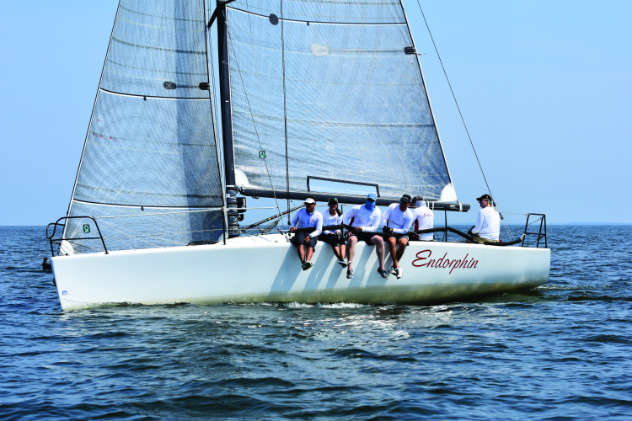Sail Trim: Telltales Tell the Tale, Part 2... Last month, we discussed telltales and head sail trim. Here are some tips for other positions on the boat.
There is an old sail trim adage: “trim the front of the jib and back of the mainsail,” or where the wind meets and leaves the sail plan. Telltales are a key tool helping you figure out what is going on at these critical junctures, and that is why they are placed just aft of the leading edge of the headsail and off the leech of the mainsail. For a sail to work, air has to flow down both sides. Telltales tell us about that flow. They tell us all sorts of useful things depending on point of sail, wind velocity, and whether we are trimming or driving.
Driving upwind
If you can’t see the headsail telltales, there is no way to sail upwind efficiently. This is what makes cruising boats difficult to steer upwind. The wheel is usually so far aft to maximize cockpit space that it takes a Houdini-like act to see them. Sometimes the only way is to go to leeward to steer, which is okay in light air but not recommended in windier conditions.
Once you can see the telltales, the game is pretty simple. For maximum power the telltales need to stream straight aft. If the outside telltale spins or sags straight down, head up. If the inside telltale lifts, bear off.
In general it is better to ride the inside telltales, having them just on the verge of lifting. In medium air with the boat going well it is okay to have them lifting up so that the inside telltale is at a 45-degree angle up, and the leeward telltale remains straight back.
With good boat speed, you want to stay on the high side of the groove.
Remember the adage “speed first, then point?” In light air be careful about getting too high in the groove (inside telltale lifting). “Press” on the jib, and make sure both telltales stream aft, perhaps even allowing the outside bottom telltale to stall part of the time.
Typically you are relying on the telltales in the window, the bottom set, but in light air it might be better to move your eyes up to the middle set of telltales, because the bottom outside will tend to stall. This is when it is okay to steer from the leeward side to see the whole sail. Your weight down will help create needed heel anyway. If the sail is stalled at the bottom all the time in order to keep the boat moving, it may just be over-trimmed. Ease slightly.
In windier conditions telltales become less important. Angle of heel rules. As a puff hits, don’t try to keep the telltales flowing; let the boat head up to maintain the same angle of heel and keep the helm pressure constant. The inside telltales will lift indicating a luffing sail. This is called “feathering.” Feather, don’t fight. Sail a constant angle of heel letting the boat come up in the puffs and bearing off to add heel in the lulls.

Mainsail trimmer
Off the wind the standard rule applies. Let the main out until it luffs along the leading edge, and then trim in just enough to stop. Telltales come in when setting twist. With the boom eased out it begins to lift, opening, or twisting the leech. If it is too open, you are giving away power. Too closed and the flow will be stalled off the trailing edge. The telltales should be streaming. The vang takes care of pulling down and controlling twist on a reach, so add vang until the top telltale just begins to stall. The top telltale is the key. It will stall first.
On a deep run with the mainsail eased all the way out perpendicular to the boat (or up against the shrouds), it may not be possible to get attached flow off the back of the sails; and the telltales may not be useful. In this scenario you just have to go back to keeping the top batten parallel to the boom.
Upwind, the mainsheet (sometimes helped out by the vang in windier conditions) takes over the job of controlling twist. In light air make sure there is flow off the back of the sail by having all the telltales flowing. More twist makes it easier for the boat to accelerate. Again, the top telltale will stall first if you are over-trimmed and pulling down too hard. It is almost impossible to stall the lower telltales unless you are grossly over-trimmed.
In medium conditions you can sheet harder since the boat is now up to speed. Trim as hard as you can without slowing the boat down below target speed. The top telltale may be stalled a lot of the time.
In heavy air it is just a matter of keeping the boat on her feet. Ease the mainsheet to control heel and helm. The telltales will always be streaming, but they are no longer the issue.
Those other telltales
Sometimes we use telltales in addition to the ones on the luff of the jib and the leech of the mainsail.
On a non-overlapping jib, telltales can be used on the leech to indicate flow. As usual, it is the top telltale that counts. Usually there is only a single telltale in the upper 25 percent of the leech. Trim too hard or pull the lead too far down (or too far forward) for conditions, and that telltale will stall. Twist is essential in a non-overlapping sail, so you always want the telltale flying.
Additional telltales are also used sometimes in the upper sections of the mainsail across the middle of the sail. They help refine the twist picture and give a more subtle indication of how hard you are trimming the mainsail. They may indicate stalled flow before the leech telltale disappears. Again, they are in the top sections of the sail, because that is where the sail will stall first if over-trimmed. If they are too close to the mast, the disturbed flow behind the spar will make them useless.
~by David Flynn
Questions? email David Flynn at Quantum





